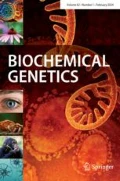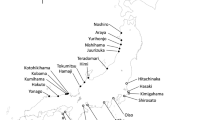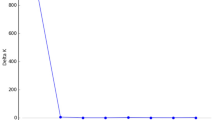Abstract
RAPD markers were used to detect genetic diversity and population genetic differentiation of Hippophae rhamnoides ssp. yunnanensis, a sea buckthorn endemic to the Qinghai-Tibet plateau. The genetic parameters of percentage of polymorphic bands (92.86%), Nei’s gene diversity (h, 0.255), and Shannon’s index (I, 0.397) indicated high genetic diversity in this subspecies. The subpopulation differentiation suggested that 45.9% of genetic variation was among populations. High genetic differentiation among populations was also detected using AMOVA (47.02%). The main factors responsible for high genetic differentiation are probably related to natural geographic barriers among populations, gene drift, and limited gene flow caused by restricted pollen flow and seed flow. A Mantel test indicated that geographic distances were significantly correlated with genetic distances. The UPGMA phenogram based on Nei’s unbiased genetic distances and the result of three-dimensional model plots performed by principal coordinate analysis also supported the correlation. Altitude, however, did not have any clear effect on genetic differentiation.



Similar content being viewed by others
References
Alpert P, Lumaret RD, Giusto F (1993) Population structure inferred from allozyme analysis in the clone herb Fragaria chiloensis (Rosaceae). Am J Bot 80:1002–1006
Bartish IV, Jeppsson N, Nybom H (1999) Population genetic structure in the dioecious pioneer plant species Hippophae rhamnoides investigated by RAPD markers. Mol Ecol 8:791–802
Bartish IV, Jeppsson N, Bartish GI, Lu R, Nybom H (2000) Inter- and intraspecific genetic variation in Hippophae (Elaeagnaceae) investigated by RAPD markers. Plant Syst Evol 225:85–101
Bartish IV, Jeppsson N, Nybom H, Swenson U (2002) Phylogeny of Hippophae (Elaegnaceae) inferred from parsimony analysis of chloroplast DNA and Morphology. Syst Bot 27:41–54
Bartish IV, Kadereit JW, Comes HP (2006) Late Quaternary history of Hippophae rhamnoides L. (Elaeagnaceae) inferred from chalcone synthase intron (Chsi) sequences and chloroplast DNA variation. Mol Ecol 15(13):4065–4083
Bussell JD (1999) The distribution of random amplified polymorphic DNA (RAPD) diversity amongst populations of Isotoma petraea (Lobeliaceae). Mol Ecol 8:775–789
Chen G, Wang Y, Zhao C, Korpelainen H, Li C (2008) Genetic diversity of Hippophae rhamnoides populations at varying altitudes in the Wolong Natural Reserve of China as revealed by ISSR markers. Silvae Genet 57(1):27–36
Comes HP, Abbott RJ (2000) Random amplified polymorphic DNA (RAPD) and quantitative trait analyses across a major phylogeographic break in the Mediterranean ragwort Senecio gallicus Vill. (Asteraceae). Mol Ecol 9:61–76
Cosner ME, Crawford DL (1994) Comparisons of isozyme diversity in three rare species of Coreopsis (Asteraceae). Syst Bot 19(3):350–358
Dawson IK, Simon AJ, Waugh R, Powell W (1995) Diversity and genetic differentiation among subpopulations of Gliricidia sepium revealed by PCR-based assays. Heredity 74:10–18
Eliseev IP, Mazaeva EY, Malena TV, Ivashin II (1989) Formovae raznoobrazie nekotorykh populyatsii Hippophae rhamnoides L. v Kirgizskoi SSR. Rast Resursy 20:502–509
Ercan AG, Taskin M, Turgut K (2004) Analysis of genetic diversity in Turkish sesame (Sesamum indicum L.) populations using RAPD markers. Genet Resour Crop Evol 51:599–607
Esselman EJ, Li JQ, Crawford D, Winduss JL, Wolfe AD (1999) Clonal diversity in the rare Calamagrostis porteri ssp. insperata (Poaceae): comparative results for allozymes and random amplified polymorphic DNA (RAPD) and inter-simple sequence repeat (ISSR) markers. Mol Ecol 8:443–451
Fang DQ, Roose ML (1997) Identification of closely related Citrus cultivars with inter-simple sequence repeat markers. Theor Appl Genet 95:408–417
Gabrielsen TM, Bachmann K, Jakobsen KS, Brochmann C (1997) Glacial survival does not matter: RAPD phylogeography of Nordic Saxifraga oppositifolia. Mol Ecol 6:831–842
Ge S, Hong DY (1999) Studies of morphological and allozyme variation of the endangered Adenophora lobophylla and its widespread congener A. potaninii. Acta Genet Sin 26(4):140–147 (in Chinese)
Ge S, Oliveira GCX, Schaal BA, Gao LZ, Hong DY (1999) RAPD variation within and between natural populations of the wild rice Oryza rufipogon from China and Brazil. Heredity 82:638–644
Graham J, Squire GR, Marshall B, Harrison RE (1997) Spatially dependent genetic diversity within and between colonies of wild raspberry Rubus idaeus detected using RAPD markers. Mol Ecol 6:1001–1008
Hamrick JL, Godt MJW (1990) Allozyme diversity in plant species. In: Brown AHD et al (eds) Plant population genetics, breeding and genetic resources. Sinauer Associates, Inc., Sunderland, pp 43–63
Hamrick JL, Godt MJW, Murawski DA, Loveless MD (1991) Correlations between species and allozyme diversity: implications for conservation biology. In: Falk DA, Holsinger KE (eds) Genetics and conservation of rare plants. Oxford University Press, New York, pp 75–86
Heum M, Murrhy JP, Phillips TD (1994) A comparison of RAPD and isozyme analyses for determining the genetic relationships among Avena sterilis L. accessions. Theor Appl Genet 87:689–696
Huff DR, Peakall R, Smouse PE (1993) RAPD variation within and among natural populations of outcrossing buffalograss [Buchloë dactyloedes (Nutt.) Engelm.]. Theor Appl Genet 86:927–934
Li JM, Jin ZX (2006) High genetic differentiation revealed by RAPD analysis of narrowly endemic Sinocalycanthus chinensis Cheng et S.Y. Chang, an endangered species of China. Biochem Syst Ecol 34:725–735
Li M, Midmore DJ (1999) Estimating the genetic relationships of Chinese water chestnut (Eleocharis dulcis (Burm. f.) Hensch) cultivated in Australia, using Random amplified polymorphic DNAs (RAPDs). J Hort Sci Biotech 74:224–231
Li J, Tao Y, Zheng SZ, Zhou JL (1995) Isozymatic differentiation in local population of Glycine soja Sieb. & Zucc. Acta Bot Sin 37:669–676
Lian YS, Lu SG, Xue SK, Chen XL (2000) Biology and chemistry of the genus Hippophae. Gansu Science & Technology Press, Lanzhou, pp 1–226 (in Chinese)
Liu ZL, Li S, Yan GQ, Song Y, Zhao GF (2001) Genetic structure and intraspecific genetic polymorphisms in natural populations of Psathyrostachys huashanica. Acta Genet Sin 28(8):769–777
Nei M (1978) Estimation of average heterozygosity and genetic distance from a small number of individuals. Genetics 89:583–590
Parsons BJ, Newbury HJ, Jackson MT, Ford-Lloyd BV (1997) Contrasting genetic diversity relationships are revealed in rice (Oryza sativa L.) using different marker types. Mol Breed 3:115–125
Persson HA, Nybom H (1998) Genetic sex determination and RAPD marker segregation in the dioecious species sea buckthorn (Hippophae rhamnoides L.). Hereditas 129:45–51
Qian W, Ge S, Hong DY (2001) Genetic variation within and among populations of a wild rice Oryza granulata from China detected by RAPD and ISSR markers. Theor Appl Genet 102:440–449
Raybould AF, Mogg RJ, Clarke RT (1996) The genetic structure of Beta vulgaris ssp. inaritima (sea beet) populations: RFLPs and isozymes show different pattern of gene flow. Heredity 77:245–250
Richter TS, Soltis PS, Soltis DE (1994) Genetic variation within and among populations of the narrow endemic Delphinium viridescens (Ranunculaceae). Am J Bot 81(8):1070–1076
Sheng HM, An LZ, Chen T, Xu SJ, Liu GX, Zheng XL, Pu LL, Liu YJ, Lian YS (2006) Analysis of the genetic diversity and relationships among and within species of Hippophae (Elaeagnaceae) based on RAPD markers. Plant Syst Evol 260:25–37
Singh V, Singh B, Awasthi CP (1997) Studies on distribution, taxonomy and nutritional values of sea buckthorn growing in dry temperate Himalayas. In: Lu S et al, (eds) Worldwide research & development of sea buckthorn. China Science & Technology Press, Beijing, pp 52–59
Sun K, Chen XL, Ma RJ, Li CB, Wang Q, Ge S (2002) Molecular phylogenetics of Hippophae L. (Elaeagnaceae) based on the internal transcribed spacer (ITS) sequences of nrDNA. Plant Syst Evol 235:121–134
Sun K, Chen W, Ma RJ, Chen XL, Li A, Ge S (2006) Genetic variation in Hippophae rhamnoides ssp. sinensis (Elaeagnaceae) revealed by RAPD markers. Biochem Genet 44(5/6):186–197
Tian CJ, Nan P, Shi SH, Chen JK, Zhong Y (2004) Molecular genetic variation in Chinese populations of three subspecies of Hippophae rhamnoides. Biochem Genet 42:259–267
Tollefsrud MM, Bachmann K, Jakobsen KS, Brochmann C (1998) Glacial survival does not matter—II: RAPD phylogeography of Nordic Saxifraga cespitosa. Mol Ecol 7:1219–1232
Wang Q (2003) Genetic diversity of three species of Ligularia (Asteraceae) in eastern of Qinghai-Tibet plateau of China. M.D. Thesis, pp 14–19 (in Chinese)
Wright S (1931) Evolution in Mendelian population. Genetics 16:91–159
Wu W, Zheng YL, Chen L, Wei YM, Yang RW, Yan ZH (2005) Evaluation of genetic relationships in the genus Houttuynia Thunb. in China based on RAPD and ISSR markers. Biochem Syst Ecol 33:1141–1157
Yao Y, Tigerstedt PMA (1993) Isozyme studies of genetic diversity and evolution in Hippophae. Genet Resour Crop Evol 40:153–164
Yao Y, Tigerstedt PMA (1994) Genetic diversity in Hippophae and its use in plant breeding. Euphytica 77:165–169
Yeh EC, Yang RC, Boyle TBJ, Ye ZH, Mao JX (1997) Popgene, the user-friendly shareware for population genetic analysis. Edmonton: molecular biology and biotechnology centre. University of Alberta, Canada
Young AG, Hill JH, Murray BG, Peakall R (2002) Breeding system, genetic diversity and clonal structure in the subalpine forb Rutidosis leiolepis F. Muell. (Asteraceae). Biol Conserv 106:71–78
Zhao QF, Li QX, Ma SR, Cui Y, Wang G (2006) RAPD analysis of genetic diversity of Kobresia humilis along the eastern of Qinghai-Tibet plateau of China. Acta Ecol Sin 26:2494–2501 (in Chinese)
Acknowledgments
Prof. Xin-Ping Wang (www.amaurobiidae.com) at the University of Florida provided comments on the manuscript. This research was supported by the National Natural Science Foundation of China (30960029), Science and Knowledge Innovation Project of Northwest Normal University (NWNU-KJCXGC-03-49).
Author information
Authors and Affiliations
Corresponding author
Rights and permissions
About this article
Cite this article
Chen, W., Su, X., Zhang, H. et al. High Genetic Differentiation of Hippophae rhamnoides ssp. yunnanensis (Elaeagnaceae), a Plant Endemic to the Qinghai-Tibet Plateau. Biochem Genet 48, 565–576 (2010). https://doi.org/10.1007/s10528-010-9339-y
Received:
Accepted:
Published:
Issue Date:
DOI: https://doi.org/10.1007/s10528-010-9339-y




